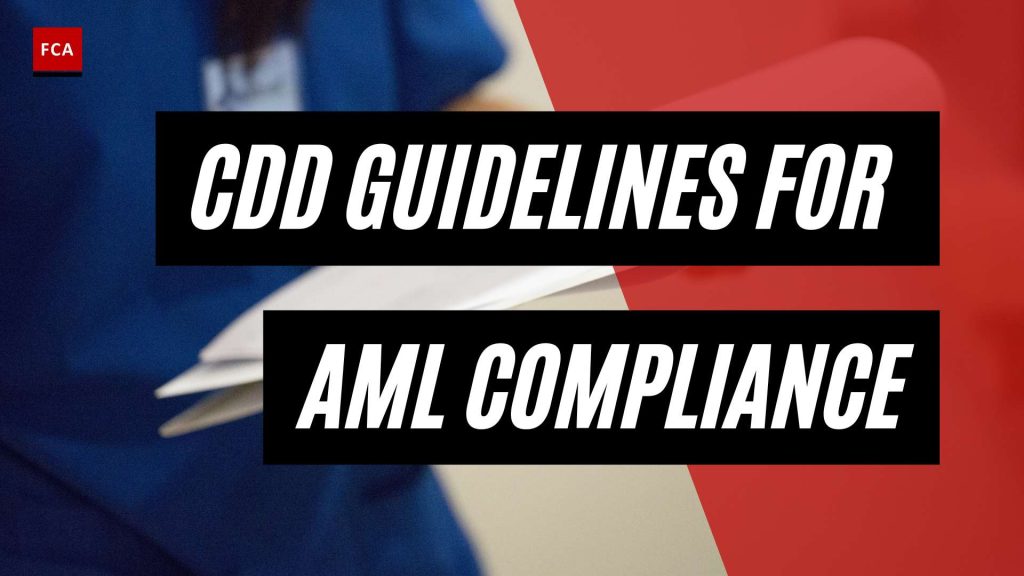Understanding Customer Due Diligence (CDD)
Customer Due Diligence (CDD) plays a crucial role in compliance, particularly in the financial sector. It is an essential process that helps verify customer identities, assess criminal risks accurately, and ensure compliance with anti-money laundering (AML) regulations. By implementing effective CDD practices, organizations can safeguard themselves against financial crimes and maintain regulatory compliance.
The Importance of CDD in Compliance
Demonstrating the effectiveness of compliance programs in financial crime has become increasingly crucial due to the growing robustness of regulations in the industry (Swift). CDD is a foundational element of the Know Your Customer (KYC) process, which is required by the Financial Action Task Force (FATF) members. It involves collecting customer information, verifying identities through official documents, understanding customer behavior, and assessing money laundering or terrorism financing risks (ComplyAdvantage).
By conducting thorough CDD, organizations can establish a strong defense against illicit activities such as money laundering, fraud, and terrorist financing. It enables them to identify high-risk customers, monitor transactions effectively, and ensure compliance with regulatory requirements. Furthermore, implementing robust CDD measures helps organizations build trust and credibility with regulators, stakeholders, and customers.
Key Components of CDD
The CDD process consists of several key components that organizations must adhere to in order to maintain compliance and mitigate risks.
-
Establishing Customer Identity: The first step in the CDD process is to establish the identity of the customer. This involves collecting information such as name, address, date of birth, and official identification documents. By verifying customer identities, organizations can ensure that they are dealing with legitimate individuals or entities.
-
Verifying Customer Information: Once the customer identity is established, organizations must verify the provided information. This can be done through various means, including official databases, third-party identity verification services, and customer interviews. Verifying customer information helps detect any discrepancies, potential fraud, or illegal activities.
-
Risk-Based Approach to CDD: Companies should implement a risk-based approach to CDD, taking into consideration factors such as the customer’s profile, transactional behavior, and the jurisdiction in which they operate. This allows organizations to allocate resources effectively by focusing enhanced due diligence (EDD) measures on high-risk customers and streamlining the CDD process for low-risk customers (ComplyAdvantage).
-
Enhanced Due Diligence (EDD) for High-Risk Customers: High-risk customers, such as politically exposed persons (PEPs) or customers targeted by economic sanctions, require additional scrutiny. Enhanced Due Diligence (EDD) measures should be implemented for these customers, which may involve conducting deeper background checks, assessing the source of funds, and monitoring transactions more closely. EDD helps organizations identify and mitigate potential risks associated with high-risk customers.
By following these key components of CDD, organizations can establish a robust compliance framework, mitigate risks effectively, and ensure adherence to regulatory requirements. It is important to maintain accurate and up-to-date records and documentation throughout the CDD process to demonstrate compliance and facilitate audits when required.
For detailed information on the regulatory requirements, best practices, and challenges associated with CDD, refer to our related articles on cdd requirements, cdd training, cdd documentation, customer due diligence process, and cdd regulations.
Implementing an Effective CDD Process
To effectively implement Customer Due Diligence (CDD) guidelines, companies should adopt a risk-based approach, establish customer identity, verify customer information, and apply Enhanced Due Diligence (EDD) measures for high-risk customers.
Risk-Based Approach to CDD
Implementing a risk-based approach to CDD allows companies to balance compliance obligations, budget constraints, and customer experience considerations. This approach involves categorizing customers based on their risk levels and tailoring the intensity of due diligence measures accordingly. Low-risk customers undergo faster and more efficient CDD processes, while high-risk customers require more in-depth scrutiny and EDD measures. High-risk customer assessments may include evaluating politically exposed persons (PEPs) and customers targeted by economic sanctions (ComplyAdvantage). By applying the risk-based approach, companies can allocate appropriate resources and controls based on the level of risk, ensuring effective compliance with CDD guidelines (AML-CFT).
Establishing Customer Identity
Establishing customer identity is a fundamental step in the CDD process. Companies should collect and verify essential information to ensure the accuracy and legitimacy of customer identities. This may include obtaining identification documents, such as passports or driver’s licenses, and verifying their authenticity. By accurately establishing customer identity, companies can mitigate the risk of fraud, identity theft, and illicit activities.
Verifying Customer Information
Verifying customer information is a crucial aspect of CDD. It involves conducting thorough checks to confirm the accuracy and reliability of the information provided by customers. Companies may employ various methods for verification, such as comparing customer-provided data against trusted sources, conducting database searches, or engaging third-party CDD services. Verification processes may differ based on the risk profile of the customer. It is important for companies to ensure that the verification methods used align with regulatory requirements and industry best practices.
Enhanced Due Diligence (EDD) for High-Risk Customers
For high-risk customers, such as PEPs or those involved in high-value transactions, Enhanced Due Diligence (EDD) measures are necessary. EDD involves conducting a more comprehensive examination of the customer’s background, connections, and potential risks associated with the business relationship. This may include conducting additional research, gathering supplementary information, and performing enhanced monitoring. By implementing EDD measures, companies can better understand the potential risks and take appropriate steps to mitigate them.
By following an effective CDD process, companies can comply with regulatory requirements, mitigate the risk of financial crimes, and protect themselves from penalties and reputational damage. It is important for companies to maintain accurate records and documentation of the CDD process for at least five years to demonstrate compliance with regulations (ComplyAdvantage). Additionally, companies should consider utilizing third-party CDD services to enhance efficiency and accuracy in the verification process.
Regulatory Requirements for CDD
In order to strengthen anti-money laundering (AML) efforts and mitigate the risk of financial crimes, regulatory authorities have established guidelines and rules for Customer Due Diligence (CDD). These guidelines outline the necessary steps and requirements that financial institutions must follow to ensure compliance. Let’s explore some of the key regulatory requirements for CDD.
Customer Due Diligence (CDD) Guidelines
The Financial Action Task Force (FATF) provides comprehensive guidelines on Customer Due Diligence (CDD) for financial institutions. These guidelines emphasize the importance of undertaking CDD measures when establishing business relationships, carrying out transactions above designated thresholds (e.g., USD/EUR 15,000), or when there are suspicions of money laundering or terrorist financing.
The FATF recommends that financial institutions identify and verify the identity of the customer and beneficial owner using reliable, independent source documents, data, or information. This helps ensure transparency and prevents the misuse of financial systems for illicit activities. Financial institutions are also required to obtain information on the purpose and intended nature of the business relationship and conduct ongoing due diligence to monitor transactions and ensure consistency with the institution’s knowledge of the customer, their business, and risk profile.
To comply with these guidelines, financial institutions must apply a risk-based approach (RBA) to CDD. This means determining the extent of CDD measures based on the risk assessed for each customer. By applying an RBA, institutions can allocate resources effectively and prioritize high-risk customers for enhanced due diligence (EDD).
Financial Action Task Force (FATF) Recommendations
The FATF is an international organization that sets standards and promotes the implementation of effective measures to combat money laundering, terrorist financing, and other related threats to the integrity of the international financial system. The FATF provides recommendations that member countries and financial institutions should follow to strengthen their AML frameworks.
Their recommendations emphasize the need for robust CDD procedures to identify, verify, and understand the customers and beneficial owners involved in financial transactions. By adhering to these recommendations, financial institutions can mitigate the risk of facilitating money laundering activities.
Customer Due Diligence (CDD) Rule in the United States
In the United States, the Financial Crimes Enforcement Network (FinCEN) has implemented the Customer Due Diligence (CDD) Rule. This rule, which amends the Bank Secrecy Act regulations, aims to enhance financial transparency and prevent criminals and terrorists from using financial institutions to disguise illicit activities. The CDD Rule applies to various financial institutions such as banks, mutual funds, brokers, dealers in securities, futures commission merchants, and introducing brokers in commodities.
Under the CDD Rule, covered financial institutions are required to identify and verify the identity of the natural persons, known as beneficial owners, of legal entity customers when these entities open accounts. This includes individuals who own 25 percent or more of a legal entity, as well as individuals who control the legal entity. By obtaining beneficial ownership information, financial institutions can enhance their ability to detect and prevent money laundering and other illicit activities.
Financial institutions are also required to establish and maintain written policies and procedures that are reasonably designed to comply with the standards and objectives of the CDD Rule. These policies and procedures ensure that institutions have a systematic and consistent approach to CDD and that they meet the regulatory requirements.
By adhering to these regulatory requirements, financial institutions can contribute to the global fight against money laundering and terrorist financing while maintaining the integrity of the financial system. Compliance with CDD guidelines and regulations is crucial for the effective implementation of AML measures and the protection of financial institutions and their customers.
Best Practices for CDD Compliance
To ensure effective compliance with CDD regulations and mitigate the risk of financial crime, financial institutions should implement best practices for Customer Due Diligence. By following these guidelines, institutions can strengthen their AML (Anti-Money Laundering) compliance programs and protect themselves from potential penalties and reputational damage. Here are some key best practices for CDD compliance:
Maintaining Records and Documentation
Financial institutions must establish and maintain written policies and procedures that are reasonably designed to comply with CDD requirements (FinCEN). This includes the need to maintain accurate records and documentation related to customer due diligence activities. Keeping detailed records of customer identification, verification, and ongoing monitoring helps institutions demonstrate their compliance with regulatory obligations.
Maintaining comprehensive records also supports the ability to conduct internal and external audits, investigations, and reporting when necessary. By documenting all CDD processes and outcomes, financial institutions can provide evidence of their due diligence efforts and assist in the identification and mitigation of potential risks.
Risk-Based Customer Relationship Management
One of the fundamental principles of CDD is the adoption of a risk-based approach. Financial institutions should assess and categorize customers based on their risk profile, taking into account factors such as jurisdiction, business type, transaction volume, and reputation. This risk assessment guides the level and extent of due diligence required for each customer.
By implementing risk-based customer relationship management, institutions can allocate their resources effectively, focusing their CDD efforts on high-risk customers who pose a greater threat of money laundering or other illicit activities. This approach allows for a more efficient and targeted allocation of resources while ensuring that adequate due diligence measures are in place for higher-risk relationships.
Utilizing Third-Party CDD Services
In some instances, financial institutions may consider utilizing third-party services to assist with certain aspects of CDD. Third-party providers can offer specialized expertise, technology solutions, and data sources that augment an institution’s own capabilities. These services may include identity verification, screening against watchlists and sanctions lists, and enhanced data analytics.
When engaging third-party CDD services, financial institutions must conduct thorough due diligence on the providers themselves. This includes assessing their reputation, track record, compliance controls, and data security measures. It is essential to ensure that the third-party services align with the institution’s regulatory obligations and risk appetite.
Ongoing Monitoring and Review
CDD is not a one-time process but requires ongoing monitoring and review of customer relationships. Financial institutions should establish mechanisms to identify and promptly address any changes in customer behavior, account activity, or risk profile. Regularly reviewing customer information and conducting periodic reassessments helps institutions detect and respond to any suspicious or unusual activity.
Ongoing monitoring includes the use of transaction monitoring systems, which can flag potentially suspicious activities based on predefined risk indicators. These systems analyze customer transactions and behavior patterns to identify anomalies that may warrant further investigation.
By implementing best practices for CDD compliance, financial institutions can enhance their ability to detect and prevent financial crime while meeting their regulatory obligations. Maintaining accurate records, adopting a risk-based approach, utilizing third-party services, and conducting ongoing monitoring and review are vital components of a robust CDD program. These practices assist institutions in safeguarding their operations, reputation, and the integrity of the financial system as a whole.
Challenges and Considerations in CDD
Implementing effective Customer Due Diligence (CDD) guidelines comes with its own set of challenges and considerations. Companies must strike a balance between compliance, budget constraints, and customer experience. Technology and data analytics play a crucial role in enhancing the efficiency of CDD processes. Inadequate CDD can result in severe penalties and consequences. Let’s explore these challenges further.
Balancing Compliance, Budget, and Customer Experience
Companies face the challenge of balancing their compliance obligations with budget constraints and customer experience considerations. Striking this balance is crucial to ensure effective CDD implementation. A risk-based approach (RBA) can help achieve this balance. By categorizing customers based on risk levels, companies can allocate resources more efficiently. Low-risk customers can undergo faster and more streamlined CDD processes, while high-risk customers require more intense scrutiny through Enhanced Due Diligence (EDD) measures. This approach allows companies to focus their resources on higher-risk areas while providing a smoother experience for low-risk customers (ComplyAdvantage).
Technology and Data Analytics in CDD
The complexity and evolving nature of CDD requirements make it challenging for financial institutions to keep up. Technology and data analytics can significantly enhance the efficiency and effectiveness of CDD processes. By automating certain tasks, such as identity verification and risk assessment, companies can streamline their workflows and reduce the burden on manual processes. Advanced data analytics can help identify patterns and anomalies, enabling companies to detect potential risks more effectively. Implementing robust technological solutions can enhance the accuracy and speed of CDD processes, ultimately improving overall compliance efforts (Flagright).
Penalties and Consequences of Inadequate CDD
Failure to conduct adequate CDD can have severe consequences for financial institutions. Not only can it result in significant financial and reputational damage, but it can also lead to regulatory and legal penalties. Regulators expect companies to have robust CDD procedures in place to mitigate money laundering, terrorism financing, and other illicit activities. Inadequate CDD controls have resulted in notable cases of penalties, such as Deutsche Bank being fined $150 million in 2020 by the New York State Department of Financial Services for lacking sufficient CDD controls (Flagright).
To mitigate these risks, companies must prioritize the implementation of comprehensive and effective CDD processes. This includes establishing clear policies and procedures, maintaining accurate records and documentation, and staying up to date with regulatory requirements. Regular training and education for employees involved in CDD processes are essential to ensure compliance and mitigate potential risks (cdd training). By prioritizing compliance, companies can protect their reputation, avoid penalties, and contribute to the overall integrity of the financial system.
In the next sections, we will explore best practices for CDD compliance, as well as the specific considerations in various industries such as the banking sector, financial services, and other high-risk industries.
CDD in Specific Industries
Customer Due Diligence (CDD) is a crucial process in various industries to mitigate the risk of money laundering and other illicit activities. Let’s explore how CDD guidelines are implemented in the banking sector, financial services, and other high-risk industries.
CDD in the Banking Sector
In the banking sector, adherence to CDD guidelines is of utmost importance to ensure the integrity of the financial system and prevent illicit activities. The guidelines set forth by regulatory bodies emphasize the following key points:
- Prohibition of anonymous accounts or accounts in obviously fictitious names
- Requirement to undertake CDD measures when establishing business relationships, conducting occasional transactions above the designated threshold, when there is suspicion of money laundering or terrorist financing, or when there are doubts about the veracity or adequacy of previously obtained customer identification data
- Identification and verification of customer identity and beneficial ownership using reliable, independent source documents, data, or information
- Obtaining information on the purpose and intended nature of the business relationship
- Conducting ongoing due diligence on the business relationship and scrutinizing transactions to ensure consistency with the institution’s knowledge of the customer, their business, and risk profile
- Application of CDD measures using a risk-based approach (RBA) to determine the extent of measures based on the assessed risk
These guidelines, as outlined by the CFATF, serve as a framework for banks to establish robust CDD processes and effectively mitigate risks associated with money laundering and terrorist financing.
CDD in Financial Services
Similar to the banking sector, financial services institutions are required to adhere to CDD guidelines to combat illicit financial activities. The guidelines set forth by regulatory bodies mirror those in the banking sector and include:
- Prohibition of anonymous accounts or accounts in obviously fictitious names
- Requirement to undertake CDD measures when establishing business relationships, conducting occasional transactions above the designated threshold, when there is suspicion of money laundering or terrorist financing, or when there are doubts about the veracity or adequacy of previously obtained customer identification data
- Identification and verification of customer identity and beneficial ownership using reliable, independent source documents, data, or information
- Obtaining information on the purpose and intended nature of the business relationship
- Conducting ongoing due diligence on the business relationship and scrutinizing transactions to ensure consistency with the institution’s knowledge of the customer, their business, and risk profile
- Application of CDD measures using a risk-based approach (RBA) to determine the extent of measures based on the assessed risk
By adhering to these guidelines, financial services institutions can build a strong defense against money laundering and other financial crimes.
CDD in Other High-Risk Industries
Beyond the banking sector and financial services, other high-risk industries must also implement robust CDD measures to prevent illicit activities. These industries may include sectors such as real estate, gambling, precious metals, and more. The CDD guidelines for these industries align with the principles established for the banking sector and financial services. Key aspects of CDD in high-risk industries include:
- Prohibition of anonymous accounts or accounts in obviously fictitious names
- Requirement to undertake CDD measures when establishing business relationships, conducting occasional transactions above the designated threshold, when there is suspicion of money laundering or terrorist financing, or when there are doubts about the veracity or adequacy of previously obtained customer identification data
- Identification and verification of customer identity and beneficial ownership using reliable, independent source documents, data, or information
- Obtaining information on the purpose and intended nature of the business relationship
- Conducting ongoing due diligence on the business relationship and scrutinizing transactions to ensure consistency with the institution’s knowledge of the customer, their business, and risk profile
- Application of CDD measures using a risk-based approach (RBA) to determine the extent of measures based on the assessed risk
Strict adherence to these guidelines helps high-risk industries mitigate the risks associated with money laundering, terrorist financing, and other illicit activities.
By implementing effective CDD practices in the banking sector, financial services, and other high-risk industries, organizations can safeguard themselves against financial crimes and contribute to the overall integrity of the global financial system.








